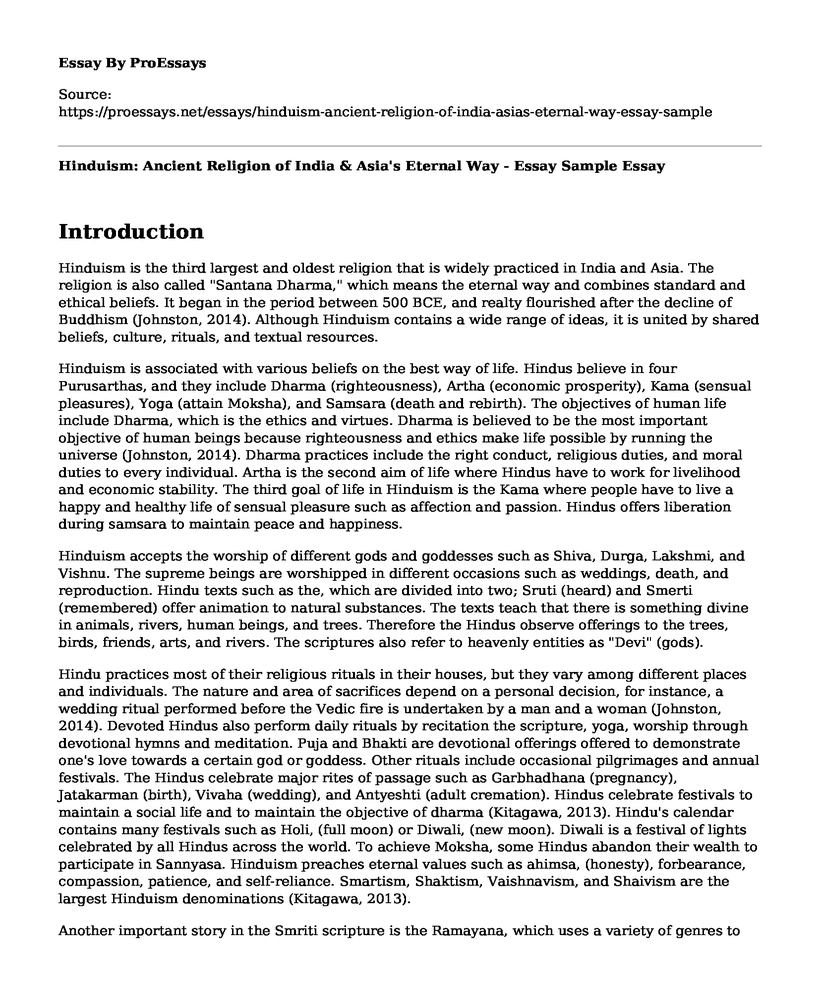Introduction
Hinduism is the third largest and oldest religion that is widely practiced in India and Asia. The religion is also called "Santana Dharma," which means the eternal way and combines standard and ethical beliefs. It began in the period between 500 BCE, and realty flourished after the decline of Buddhism (Johnston, 2014). Although Hinduism contains a wide range of ideas, it is united by shared beliefs, culture, rituals, and textual resources.
Hinduism is associated with various beliefs on the best way of life. Hindus believe in four Purusarthas, and they include Dharma (righteousness), Artha (economic prosperity), Kama (sensual pleasures), Yoga (attain Moksha), and Samsara (death and rebirth). The objectives of human life include Dharma, which is the ethics and virtues. Dharma is believed to be the most important objective of human beings because righteousness and ethics make life possible by running the universe (Johnston, 2014). Dharma practices include the right conduct, religious duties, and moral duties to every individual. Artha is the second aim of life where Hindus have to work for livelihood and economic stability. The third goal of life in Hinduism is the Kama where people have to live a happy and healthy life of sensual pleasure such as affection and passion. Hindus offers liberation during samsara to maintain peace and happiness.
Hinduism accepts the worship of different gods and goddesses such as Shiva, Durga, Lakshmi, and Vishnu. The supreme beings are worshipped in different occasions such as weddings, death, and reproduction. Hindu texts such as the, which are divided into two; Sruti (heard) and Smerti (remembered) offer animation to natural substances. The texts teach that there is something divine in animals, rivers, human beings, and trees. Therefore the Hindus observe offerings to the trees, birds, friends, arts, and rivers. The scriptures also refer to heavenly entities as "Devi" (gods).
Hindu practices most of their religious rituals in their houses, but they vary among different places and individuals. The nature and area of sacrifices depend on a personal decision, for instance, a wedding ritual performed before the Vedic fire is undertaken by a man and a woman (Johnston, 2014). Devoted Hindus also perform daily rituals by recitation the scripture, yoga, worship through devotional hymns and meditation. Puja and Bhakti are devotional offerings offered to demonstrate one's love towards a certain god or goddess. Other rituals include occasional pilgrimages and annual festivals. The Hindus celebrate major rites of passage such as Garbhadhana (pregnancy), Jatakarman (birth), Vivaha (wedding), and Antyeshti (adult cremation). Hindus celebrate festivals to maintain a social life and to maintain the objective of dharma (Kitagawa, 2013). Hindu's calendar contains many festivals such as Holi, (full moon) or Diwali, (new moon). Diwali is a festival of lights celebrated by all Hindus across the world. To achieve Moksha, some Hindus abandon their wealth to participate in Sannyasa. Hinduism preaches eternal values such as ahimsa, (honesty), forbearance, compassion, patience, and self-reliance. Smartism, Shaktism, Vaishnavism, and Shaivism are the largest Hinduism denominations (Kitagawa, 2013).
Another important story in the Smriti scripture is the Ramayana, which uses a variety of genres to bring out different themes such as historical periods, traditions, religious and political affiliations. Some genres explain Hinduism traditions and religious behaviors. The story of Ramayana provides four aims of life, and they include duty prosperity, pleasure, and freedom. The goal of every individual is to achieve the four of them to live a balanced life full of happiness and satisfaction (Kitagawa, 2013).
Conclusion
In conclusion, Hinduism is one of the most popular religious all over the world. However, unlike Christianity and Islam, Hinduism is associated with diverse beliefs and practices such as dharma to maintain peaceful coexistence among individuals. The religion allows the worship of different deities. Other rituals include rites of passages, meditation and yoga, and the offerings of a newborn baby. Although the Hinduism religion is associated with different beliefs about deities, they are united by numerous rituals and festivals found on their calendar year.
References
Johnston, C. (2014). The Mukhya Upanishads: Books of Hidden Wisdom. Kshetra Books.Kitagawa, J. (Ed.). (2013). The religious traditions of Asia: religion, history, and culture. Routledge.
Cite this page
Hinduism: Ancient Religion of India & Asia's Eternal Way - Essay Sample. (2023, Mar 27). Retrieved from https://proessays.net/essays/hinduism-ancient-religion-of-india-asias-eternal-way-essay-sample
If you are the original author of this essay and no longer wish to have it published on the ProEssays website, please click below to request its removal:
- Full Content Sermon Outline - Course Work Example
- Omniscience of God Essay
- How Confucianism Has Served as a Unifying Cultural Force in East Asia
- What Is Islam? The Importance of Being Islamic - Critical Essay
- Including Client Spirituality or Religious Beliefs in Therapy Essay
- Abraham's Life and Lessons Learned from Why God Chose Him Essay
- Essay Example on Conflict Over Jerusalem as Israel's Capital City







